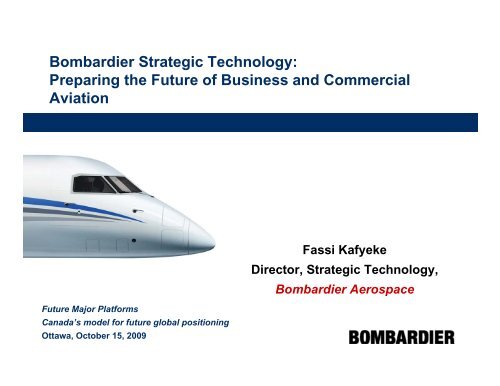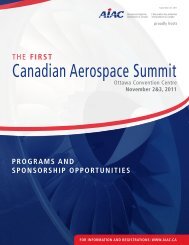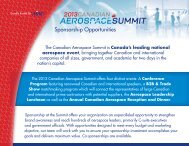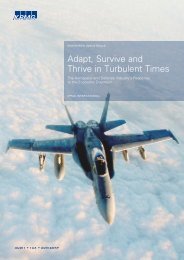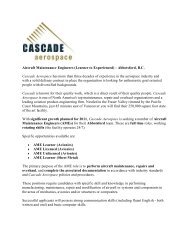Bombardier Aerospace - Aerospace Industries Association of Canada
Bombardier Aerospace - Aerospace Industries Association of Canada
Bombardier Aerospace - Aerospace Industries Association of Canada
You also want an ePaper? Increase the reach of your titles
YUMPU automatically turns print PDFs into web optimized ePapers that Google loves.
<strong>Bombardier</strong> Strategic Technology:<br />
Preparing the Future <strong>of</strong> Business and Commercial<br />
Aviation<br />
Future Major Platforms<br />
<strong>Canada</strong>’s model for future global positioning<br />
Ottawa, October 15, 2009<br />
Fassi Kafyeke<br />
Director, Strategic Technology,<br />
<strong>Bombardier</strong> <strong>Aerospace</strong>
Forward-looking Statements<br />
This presentation includes forward-looking statements. Forward-looking statements generally can be identified by the use <strong>of</strong> forward-looking<br />
terminology such as “may”, “will”, “expect”, “intend”, “estimate”, “anticipate”, “plan”, “foresee”, “believe” or “continue” or the negatives <strong>of</strong> these<br />
terms or variations <strong>of</strong> them or similar terminology. By their nature, forward-looking statements require <strong>Bombardier</strong> Inc. (the “Corporation”) to make<br />
assumptions and are subject to important known and unknown risks and uncertainties, which may cause the Corporation’s actual results in future<br />
periods to differ materially from forecasted results. While the Corporation considers its assumptions to be reasonable and appropriate based on<br />
current information available, there is a risk that they may not be accurate. For additional information with respect to the assumptions underlying<br />
the forward-looking statements made in this presentation, please refer to the respective sections <strong>of</strong> the Corporation’s aerospace segment<br />
(“<strong>Aerospace</strong>”) and the Corporation’s transportation segment (“Transportation”) in the F06 MD&A.<br />
Certain factors that could cause actual results to differ materially from those anticipated in the forward-looking statements, include risks<br />
associated with general economic conditions, risks associated with the Corporation’s business environment (such as the financial condition <strong>of</strong> the<br />
airline industry, government policies and priorities and competition from other businesses), operational risks (such as regulatory risks and<br />
dependence on key personnel, risks associated with doing business with partners, risks involved with developing new products and services,<br />
warranty and casualty claim losses, legal risks from legal proceedings, risks relating to the Corporation’s dependence on certain key customers<br />
and key suppliers, risks resulting from fixed-term commitments, human resource risk, and environmental risk), financing risks (such as risks<br />
resulting from reliance on government support, risks relating to financing support provided on behalf <strong>of</strong> certain customers, risks relating to liquidity<br />
and access to capital markets, risks relating to the terms <strong>of</strong> certain restrictive debt covenants and market risks (including currency, interest rate<br />
and commodity pricing risk). - see the Risks and Uncertainties section in the F06 MD&A. Readers are cautioned that the foregoing list <strong>of</strong> factors<br />
that may affect future growth, results and performance is not exhaustive and undue reliance should not be placed on forward-looking statements.<br />
The forward-looking statements set forth herein reflect the Corporation’s expectations as at the date <strong>of</strong> the F06 MD&A and are subject to change<br />
after such date. Unless otherwise required by applicable securities laws, the Corporation expressly disclaims any intention, and assumes no<br />
obligation to update or revise any forward-looking statements, whether as a result <strong>of</strong> new information, future events or otherwise.<br />
2
SUMMARY<br />
• Preamble<br />
• <strong>Aerospace</strong> Industry, a priority for <strong>Canada</strong><br />
• Specific Aspects <strong>of</strong> the <strong>Aerospace</strong> Industry<br />
• The New Competitive Landscape<br />
• <strong>Canada</strong> <strong>Aerospace</strong> Industry Needs<br />
• Key criteria for being on Future Major Platforms<br />
• <strong>Aerospace</strong> Technology Innovation Chain: Europe and <strong>Canada</strong><br />
• Why an FMP Technology Demonstrators Program<br />
• Objectives <strong>of</strong> the FMP Technology Demonstrators Program<br />
• <strong>Bombardier</strong> <strong>Aerospace</strong> Leadership in National Technology Collaborative<br />
Programs<br />
• CRIAQ, CAETRM, GARDN, FMP<br />
• Technology Demonstrator: Composite structures for Aircraft Fuselages<br />
• Top Level Objectives<br />
• Technologies to be demonstrated<br />
• Potential Collaborators<br />
• Benefits <strong>of</strong> the Project<br />
• Conclusions<br />
3
<strong>Aerospace</strong>: A Priority for <strong>Canada</strong><br />
• Specific Aspects <strong>of</strong> the <strong>Aerospace</strong> Industry<br />
• Safety Considerations and Regulation<br />
• Product Lifetime<br />
• Intensive Capital Needs<br />
• The New Competitive Landscape:<br />
• Globalization<br />
• The Environment<br />
• <strong>Canada</strong>’s <strong>Aerospace</strong> Industry Needs<br />
• Strengthened Canadian Original Equipment Manufacturers<br />
• Improved SME’s and Equipment Manufacturers Competitive Position on<br />
Future Major Platforms<br />
4
<strong>Canada</strong> <strong>Aerospace</strong> Industry in Numbers<br />
• 400 firms, 83 000 employees, $23.6 billion in 2008<br />
• The country’s leading advanced technology exporter (more than 80%<br />
<strong>of</strong> output is exported)<br />
• Global market leaders in regional and business aircraft, avionics,<br />
commercial helicopters, aircraft engines, flight simulation, landing gear<br />
and space systems<br />
• Globally competitive suppliers for structures, electronics, systems,<br />
communications and maintenance, repair and overhaul<br />
5
Specific Aspects <strong>of</strong> the <strong>Aerospace</strong> Industry<br />
• Safety Considerations and Regulations<br />
• Lead to long and expensive aircraft development cycles: 5 to 10 years to<br />
develop and validate new technology before selection on an aircraft<br />
program<br />
• Example: composites, more electric systems, advanced navigation<br />
systems<br />
• Product Lifetime<br />
• Aircraft remain in service for 20 to 30 years<br />
• Technologies implemented today will affect the environment for the next<br />
40 years<br />
• Intensive Capital Needs<br />
• Launch <strong>of</strong> a new product requires intensive capital investment<br />
• It is therefore crucial to reduce the risks <strong>of</strong> introducing new technology,<br />
hence the absolute need for a technology demonstration phase<br />
6
The New Competitive Landscape<br />
• Globalization: Increased Competition<br />
• Strengthened Traditional Competitors: USA, Western Europe, Russia,<br />
Brazil, Japan<br />
• Emerging Countries: China, India, South-Korea; low-cost and well<br />
supported by government infrastructure programs<br />
• To strive in this new competitive environment, Europe and the USA are<br />
changing the game and establishing strong and durable product<br />
discriminators<br />
• Launch <strong>of</strong> technologically advanced new platforms (composites, more electric<br />
aircraft, integrated avionics) with the emphasis on protecting the environment<br />
• The Environment<br />
• Public opinion and the new environmental regulations require the<br />
development <strong>of</strong> aircraft with a lower environmental footprint<br />
To remain competitive, the Canadian <strong>Aerospace</strong> Industry<br />
must be positioned for this technological change<br />
7
<strong>Canada</strong> <strong>Aerospace</strong> Industry Needs<br />
• Strengthened Canadian Original Equipment Manufacturers<br />
• Strengthen Existing Canadian <strong>Aerospace</strong> Innovation Networks (Institute<br />
for <strong>Aerospace</strong> Research, national and provincial research consortia)<br />
• Complete the Chain <strong>of</strong> Innovation by Establishing a Canadian Technology<br />
Demonstrator Framework Program<br />
• Improved SME’s and Equipment Manufacturers Competitive<br />
Position on Future Major Platforms<br />
• Insure Participation <strong>of</strong> SME’s in Technology Demonstrator Programs<br />
• Increase the potential <strong>of</strong> selection <strong>of</strong> Canadian Suppliers on new domestic<br />
and international platforms<br />
Technology demonstrator programs were launched in Europe and the<br />
USA to support to their OEMs, SMEs and Equipment Manufacturers<br />
8
Key Criteria / capabilities for Suppliers<br />
To be on <strong>Bombardier</strong> and other OEM’s Future Platforms<br />
(1 <strong>of</strong> 2)<br />
• Commercial considerations<br />
• Financial health<br />
• Competitiveness <strong>of</strong> <strong>of</strong>fer (Total Life Cycle Cost)<br />
• Technical capabilities<br />
• Design competencies<br />
• Simulation/test capabilities<br />
• R&D capabilities<br />
• Operations/Manufacturing capabilities<br />
• Quality and on time delivery focus<br />
• Lean manufacturing<br />
• Robust processes<br />
• Program Management skills:<br />
• Change management<br />
• (technical, manpower, process)<br />
• On Site support<br />
To be<br />
Strengthened by<br />
FMP Technology<br />
Demonstrator<br />
Program<br />
9
Key Criteria / capabilities for Suppliers<br />
To be on <strong>Bombardier</strong> and other OEM’s Future Platforms<br />
(2 <strong>of</strong> 2)<br />
• Corporate Social responsibility<br />
• Adherence to <strong>Bombardier</strong>’s Supplier Code Of Conduct<br />
• Commit to the principles <strong>of</strong> United Nations Global Compact<br />
• Certified OHSAS 18001 or equivalent; ISO 14001 or equivalent<br />
• Participate in a CSR network<br />
• Aftermarket capabilities<br />
• Technical support<br />
• Service centers availability<br />
• Support <strong>of</strong> marketing & sales activity<br />
• Quality<br />
• Affiliation with international organizations (NADCAP, IAQG…)<br />
• AS9100 approved; Certified to a recognized QMS<br />
• Approved by a government regulatory agency<br />
10
<strong>Aerospace</strong> Technology Innovation Chain<br />
A Comparison <strong>of</strong> the European and Canadian Systems<br />
TRL: Technology Readiness Level<br />
11
Why an FMP Technology Demonstrator Program?<br />
• The Canadian <strong>Aerospace</strong> Industry invests continuously in<br />
Research and Development<br />
• The rhythm <strong>of</strong> R&D investments, affected by the economic slowdown,<br />
must be strengthened to respond to the growing<br />
challenges <strong>of</strong> Globalization and the Environment Imperative<br />
• There is a need to improve Canadian SMEs competitiveness in<br />
order to increase Canadian Contents on Future Platforms<br />
• A new program is needed to fill the growing gap between the<br />
needs <strong>of</strong> the OEMs and the capacity <strong>of</strong> the Canadian Supply<br />
Chain to fill these needs<br />
In <strong>Canada</strong>, there is currently no Framework Program to<br />
support aerospace technology demonstration, as can<br />
be found in most other major aerospace countries<br />
12
Objectives <strong>of</strong> the FMP Technology Demonstrators<br />
Program<br />
• Bring new technologies to Readiness level 7 by 2014 for<br />
application to new platforms beginning in 2017<br />
• Reinforce the Canadian supply chain and increase Canadian<br />
export<br />
• Cater to the technology needs <strong>of</strong> Canadian SME’s through<br />
collaboration between Canadian OEM’s, SME’s and equipment<br />
manufacturers; this partnership will also help develop the<br />
processes needed to apply successfully these new technologies<br />
• Develop Highly Qualified Personnel for the <strong>Aerospace</strong> Industry;<br />
universities will be associated to the FMP technology<br />
demonstrator programs<br />
Maintain <strong>Canada</strong>’s competitive position in a<br />
rapidly changing world market<br />
13
<strong>Bombardier</strong> <strong>Aerospace</strong> Leadership in National<br />
Technology Collaborative Programs<br />
• A founding and key member <strong>of</strong> CRIAQ (Consortium pour la Recherche<br />
Industrielle au Quebec)<br />
• <strong>Bombardier</strong> is leading or participating in 31 collaborative research programs<br />
involving 6 OEM’s, 13 SME’s, 4 equipment manufacturers, the national research<br />
council and several universities in <strong>Canada</strong><br />
14
<strong>Bombardier</strong> <strong>Aerospace</strong> Leadership in National<br />
Technology Collaborative Programs<br />
Co-chair <strong>of</strong> the CAETRM (Canadian Aviation Environment<br />
Technology Road Map) with the National Research Council;<br />
The Roadmap identified key technologies to be demonstrated in<br />
the FMP program<br />
• <strong>Bombardier</strong> <strong>Aerospace</strong><br />
• NRC - CNRC<br />
• Air <strong>Canada</strong><br />
• OAC<br />
• AQA<br />
• Pratt & Whitney <strong>Canada</strong><br />
• Bell Helicopter Textron <strong>Canada</strong> Inc.<br />
• Rolls-Royce Ltd.<br />
• CRIAQ<br />
• Standard Aero<br />
• Aero Montreal<br />
• Industry <strong>Canada</strong><br />
• AIAC<br />
• Messier-Dowty<br />
• Transport <strong>Canada</strong><br />
15
<strong>Bombardier</strong> <strong>Aerospace</strong> Leadership in National<br />
Technology Collaborative Programs<br />
• A founding and key member <strong>of</strong> GARDN (Green Aviation Research<br />
and Development Network), a new federally sponsored businessled<br />
network <strong>of</strong> centers <strong>of</strong> excellence<br />
• In this network, <strong>Bombardier</strong> is collaborating with 5 companies and 7<br />
universities<br />
The Canadian <strong>Aerospace</strong> Industry has a long tradition <strong>of</strong><br />
collaborative research and <strong>Bombardier</strong>’s role has been<br />
pivotal in many <strong>of</strong> these associations<br />
16
GARDN Eight Research Themes<br />
Emissions<br />
Noise<br />
Icing<br />
Aircraft<br />
Operations<br />
Performance<br />
Alternative<br />
Fuels<br />
Icing<br />
Materials &<br />
Manufacturing<br />
Processes<br />
Product Life Cycle<br />
Management<br />
17
<strong>Bombardier</strong> <strong>Aerospace</strong> Leadership in Future Major<br />
Platform Technology Roadmap<br />
• Member <strong>of</strong> the FMP technology committee<br />
• Proposed the SAGE concept for future platforms<br />
• Helped build the table <strong>of</strong> FMP technologies<br />
18
SAGE: Identifying future aviation technology drivers<br />
The aircraft <strong>of</strong> the future will be:<br />
SMART<br />
Systems<br />
AFFORDABLE<br />
Initial and Operating Cost<br />
GREEN<br />
Environmentally Friendly<br />
EFFICIENT<br />
Performance and Operation<br />
• Integrated and intelligent systems,<br />
• Air transport system optimization<br />
• Enhanced passenger comfort<br />
• To build: design, manufacturing and materials<br />
• To operate: reduced fuel consumption, maintenance and<br />
navigation fees<br />
• Reduced noise (5-10dB), CO2 (25%) and NOx (30%), Fuel<br />
consumption (25%), Materials <strong>of</strong> Concern (Chromium, etc)<br />
• Alternative fuel, Hazardous waste elimination, Green<br />
metrics for Eco Design<br />
• Advanced aero concepts , Advanced materials, more<br />
electric airframe<br />
• Power management systems, Integrated thermal<br />
management <strong>of</strong> propulsion system, Value added<br />
innovative design<br />
19
CAETRM: Technology Needs and Capability<br />
Canadian Aviation Environmental Technology RoadMap<br />
Product<br />
Development<br />
Manufacturing<br />
Environment<br />
Advanced<br />
Materials<br />
Avionics<br />
More<br />
Intelligent<br />
Systems<br />
More Electric<br />
Systems<br />
Human<br />
Performance<br />
Augmentation<br />
Future configuration<br />
development<br />
Special processes<br />
High temperature<br />
alloys<br />
In flight entertainment<br />
Diagnostics<br />
Network centric<br />
Engine technologies<br />
Remote operators<br />
Quality systems and<br />
processes<br />
Intelligent<br />
manufacturing<br />
Metallics<br />
In flight business<br />
Adaptive<br />
systems<br />
Environmental<br />
databases<br />
Logistics system<br />
integration<br />
RFID<br />
Metal Matrix<br />
Composites<br />
Open platforms /<br />
Landing aids<br />
Autonomous<br />
systems<br />
Multi-functional<br />
Display systems<br />
Adaptive over life<br />
cycle<br />
Air transport<br />
system<br />
optimization<br />
Key to FMP/SAGE<br />
Pr<strong>of</strong>iciency in <strong>Canada</strong><br />
Multi-disciplinary<br />
design optimization<br />
Lean engineering<br />
Integrated design and<br />
manufacturing<br />
Virtual prototyping,<br />
testing & integration<br />
Life analysis<br />
Prognostics and<br />
health management<br />
Advanced product<br />
development strategy<br />
Agile<br />
Automated fibre<br />
placement<br />
Machining<br />
Lean<br />
Robotics<br />
Inspection and Repair<br />
Joining<br />
Near net shape<br />
manufacturing<br />
Advanced assembly<br />
processes<br />
Noxious emissions<br />
reductions<br />
Alternative fuels<br />
Noise emissions<br />
reduction<br />
Fuel burn<br />
Materials <strong>of</strong> Concern<br />
Low cost<br />
manufacturing<br />
High temp.<br />
composites<br />
Hybrids<br />
Ceramic Matrix<br />
Composites<br />
Liquid composite<br />
moulding<br />
Advanced metallic<br />
alloys<br />
Coatings<br />
Thermosets<br />
Thermoplastics<br />
Nano materials<br />
Systems integration<br />
Augmented / synthetic<br />
Sensors<br />
vision systems<br />
Morphing<br />
Fly by wire/light<br />
systems<br />
Electric power<br />
generation & distribution<br />
Actuation<br />
Power management<br />
Advanced diagnostics<br />
Integrated Electronic<br />
Tech Manuals<br />
Synthetic training<br />
environments<br />
Human machine<br />
interface<br />
Environmental control<br />
systems<br />
These technologies will be part <strong>of</strong> the future Strategic Technology Portfolio.<br />
20
FMP Technology Demonstration:<br />
Composite Structures for Aircraft Fuselages<br />
Fixed Wing Airplanes<br />
Helicopters<br />
21
Composites Technology Demonstrator<br />
• Design, build and test demonstrator for Composite Fuselages for<br />
a fixed wing aircraft or a helicopter using Automated Fiber<br />
Placement<br />
• This project will focus on developing composite structure<br />
technologies applicable to an airplane fuselage or a helicopter<br />
fuselage.<br />
• Objectives:<br />
• Build on technologies developed separately by OEMs and NRC<br />
• Exploit NRC AFP facility<br />
• Develop SMEs in composite technologies<br />
• Demonstrate technologies to TRL Level 6<br />
• Prepare Canadian OEMs and SMEs for bidding on composite FMP<br />
22
Top level - Project Objectives<br />
• Design and Manufacture a full scale fuselage test article<br />
• Develop Automated Fibre Placement as a core technology<br />
• Develop composite airframe ancillary technologies<br />
• Supply chain development for affordable and competitive<br />
composite structures<br />
• Enhancement <strong>of</strong> composite pressure vessel design and<br />
manufacturing skills<br />
Demonstrate TRL 7 by Q4-2013 for AFP technology<br />
23
Composites Technologies to be Demonstrated<br />
• AFP monolithic laminates with<br />
integral hat stiffeners<br />
• AFP over honeycomb core<br />
• AFP with autoclave curing material<br />
• AFP with Out Of Autoclave curing<br />
material<br />
• Primary bonded joints<br />
• NDI for primary bonded joints<br />
• Liquid composite molding<br />
technologies<br />
• Compression molding<br />
technologies<br />
• OOA adhesive curing (conductive<br />
heating)<br />
• ATL and hot draping technologies<br />
• Low cost tooling<br />
• Closed cavity molding<br />
• Materials development and<br />
characterization<br />
24
Technology Advancement<br />
• Analysis, Simulation & Structural testing<br />
• Develop Stress/Design tools methodology<br />
• Stress analysis methodology for structural bonding joints / splices<br />
• Damage scenario for sandwich construction<br />
Master composite structure behavior<br />
25
Technology Advancement<br />
• Manufacturing & Quality<br />
• AFP manufacturing process<br />
• Co-cured and co-bonded large assembly<br />
• Validate Out-Of-Autoclave process<br />
• NDI technologies for sandwich construction and bonded joints<br />
• Large scale repair <strong>of</strong> sandwich construction<br />
• Bonding process and quality control<br />
• Metallic/composite/composite adhesive process and quality control<br />
• Infusion process for detail parts<br />
Select the optimum manufacturing process<br />
26
Technology Advancement<br />
• Systems testing<br />
• Validate acoustic/thermal benefits<br />
• Validate EMI/HIRF protection and lightening direct effects<br />
• Validate flammability certification requirements<br />
• (SHM) Structural Health Monitoring for composite application<br />
• Dissimilar materials and environmental protection<br />
Find systems solutions for composite structure<br />
27
Potential Collaborators<br />
• Bell Helicopter<br />
• Pratt and Whitney <strong>Canada</strong><br />
• <strong>Bombardier</strong> <strong>Aerospace</strong><br />
• Composite Atlantic Ltd.<br />
• Delastek<br />
• Avior<br />
• FDC<br />
• Avcorp<br />
• Comtec<br />
• Bristol Magellan<br />
• Universities<br />
• CTA<br />
• Composite research center<br />
Manitoba<br />
• NRC-AMTC<br />
• NRC-SMPL<br />
• NRC-IMI<br />
28
Timeline - FMP Collaborative Project<br />
2010 2011 2012 2013<br />
2014<br />
Project<br />
Planning<br />
Design Phase<br />
Manufacturing Phase<br />
Coupons & Subcomponent Testing<br />
Full Scale Testing<br />
29
Benefits <strong>of</strong> the Project<br />
• Allow Canadian suppliers to acquire Tier 1 integrator capabilities<br />
by participating in new technology demonstration programs in<br />
close association with major Canadian OEMs.<br />
• Allow the Canadian aerospace industry to move from the<br />
traditional sheet metal manufacturing technology to a new<br />
technology that will become standard on future aircraft.<br />
• Complete the innovation cycle by extending the universities<br />
research and development (TRL 1 to 4) results into the<br />
demonstration phase (TRL 5 to 7).<br />
30
Conclusions<br />
• The aerospace industry continuously invests in technology innovation. A<br />
partnership with the government in a national R&D framework program<br />
will accelerate the rhythm <strong>of</strong> new technology demonstration and maintain<br />
<strong>Canada</strong>’s competitive position in the world<br />
• The <strong>Aerospace</strong> <strong>Industries</strong> <strong>Association</strong> <strong>of</strong> <strong>Canada</strong> has submitted a report<br />
highlighting the need for a technology demonstrator program<br />
• Demonstrators are needed in various fields:<br />
• Aircraft composite structures<br />
• More Electric Aircraft systems and engines<br />
• Integrated Avionics and Advanced Vision Systems<br />
• A national framework program will allow also collaboration <strong>of</strong> Canadian<br />
OEMs, SMEs and equipment manufacturers with major R&D programs in<br />
other major aerospace countries<br />
• <strong>Bombardier</strong> <strong>Aerospace</strong> is ready to partner with Canadian suppliers and<br />
lead major collaborative technology demonstration programs<br />
31
Forward-looking Statements<br />
This presentation includes forward-looking statements. Forward-looking statements generally can be identified by the use <strong>of</strong> forward-looking<br />
terminology such as “may”, “will”, “expect”, “intend”, “estimate”, “anticipate”, “plan”, “foresee”, “believe” or “continue” or the negatives <strong>of</strong> these<br />
terms or variations <strong>of</strong> them or similar terminology. By their nature, forward-looking statements require <strong>Bombardier</strong> Inc. (the “Corporation”) to make<br />
assumptions and are subject to important known and unknown risks and uncertainties, which may cause the Corporation’s actual results in future<br />
periods to differ materially from forecasted results. While the Corporation considers its assumptions to be reasonable and appropriate based on<br />
current information available, there is a risk that they may not be accurate. For additional information with respect to the assumptions underlying<br />
the forward-looking statements made in this presentation, please refer to the respective sections <strong>of</strong> the Corporation’s aerospace segment<br />
(“<strong>Aerospace</strong>”) and the Corporation’s transportation segment (“Transportation”) in the F06 MD&A.<br />
Certain factors that could cause actual results to differ materially from those anticipated in the forward-looking statements, include risks<br />
associated with general economic conditions, risks associated with the Corporation’s business environment (such as the financial condition <strong>of</strong> the<br />
airline industry, government policies and priorities and competition from other businesses), operational risks (such as regulatory risks and<br />
dependence on key personnel, risks associated with doing business with partners, risks involved with developing new products and services,<br />
warranty and casualty claim losses, legal risks from legal proceedings, risks relating to the Corporation’s dependence on certain key customers<br />
and key suppliers, risks resulting from fixed-term commitments, human resource risk, and environmental risk), financing risks (such as risks<br />
resulting from reliance on government support, risks relating to financing support provided on behalf <strong>of</strong> certain customers, risks relating to liquidity<br />
and access to capital markets, risks relating to the terms <strong>of</strong> certain restrictive debt covenants and market risks (including currency, interest rate<br />
and commodity pricing risk). - see the Risks and Uncertainties section in the F06 MD&A. Readers are cautioned that the foregoing list <strong>of</strong> factors<br />
that may affect future growth, results and performance is not exhaustive and undue reliance should not be placed on forward-looking statements.<br />
The forward-looking statements set forth herein reflect the Corporation’s expectations as at the date <strong>of</strong> the F06 MD&A and are subject to change<br />
after such date. Unless otherwise required by applicable securities laws, the Corporation expressly disclaims any intention, and assumes no<br />
obligation to update or revise any forward-looking statements, whether as a result <strong>of</strong> new information, future events or otherwise.<br />
33


